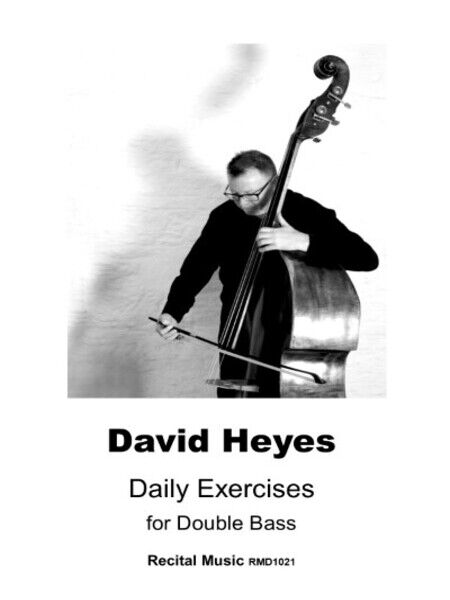Daily Exercises

Product code:
£12.50
Description
Daily Exercises for Double Bass is designed to build confidence and to develop and consolidate technique, primarily in the orchestral register of the instrument. Technique is simply a means to an end and music is the ultimate goal. Care should be taken not to put too much strain on the left hand and, much like an athlete, technique, strength and stamina should be built gradually. Do not work through the ‘pain barrier’ and ‘a little and often’ is a good maxim to follow.
The book should be seen as a starting point for you to discover and devise new technical exercises to extend and increase your technical skills throughout the entire range of the double bass. The exercises are in no particular order although the first (Chromatic Positions) is useful as a warm-up study and to develop a good hand shape.
I would suggest choosing two or three exercises each day, gradually working through the ones you feel able to tackle, eventually adding the more challenging exercises when you feel confident to do so. It is possible to adapt each exercise simply by choosing a few bars and by adding different bowing and rhythmic variations.
The exercises can be played at different dynamic levels and in different parts of the bow (heel-middle-tip), also with and without vibrato, and at different speeds. The possibilities are endless. Use them as a starting point to devise your own exercises, in different registers, and to build your technique gradually and consistently, and most importantly, remember to enjoy your bass playing.
The great Russian cellist Mstislav Rostropovich (1927-2007) once commented to a student ‘Just make it sound nice’ and these five words are applicable to every bar in this book and to every phrase you will ever play.
David Heyes
(Somerset 2021)
Useful study material:
František Černý – Technical Studies for the Double Bass (Edito Supraphon/Bärenreiter)František Černý – 30 Etudes-Caprices (Edito Supraphon/Bärenreiter)
David Heyes – Scaling the Heights – 24 Scale Studies in all keys (Recital Music)
Josef Hrabě – 86 Studies – in two volumes (Hofmeister)
Kreutzer-Simandl – 18 Studies (C.F. Schmidt)
Annibale Mengoli – 20 Concert Studies (Yorke Edition)
Édouard Nanny – Dix Études-Caprices (Alphonse Leduc)
Édouard Nanny – 20 Études de Virtuosité (Alphonse Leduc)
1. CHROMATIC POSITIONS
This exercise can be used as a warming-up study and to learn the geography of the fingerboard. The fingerings remain the same in each position allowing time to consider the left-hand shape, curved fingers, bow placement, tone and intonation. This exercise can be played on all four strings, using a variety of bowings and rhythms, and other fingering patterns can be devised to increase variety and contrast.
2. ONE OCTAVE SCALE STUDY
Scale study is at the very heart of our technical development and this exercise can be adapted for every key. There are numerous fingering possibilities for each bar and you can consider trying different ones to increase your knowledge of the lower positions of the instrument. When you are confident with the fingerings chosen, increase the challenges by adding different bowings, rhythms or dynamics.
3. HAMMER FINGERS
Aim to keep the fingers curved throughout and the exercise will help to create a strong left- hand shape. It can be played on different strings, also in thumb position, and it is possible to play the fingered notes by ‘hammering’ them onto the string (without using the bow), aiming for a ringing tone and without collapsing the fingers. One part of the exercise has the stopped note on the down bow and the second part has the stopped note on the up bow. Try different fingering and bowing combinations.
4. FOUR NOTE PATTERNS
This is a useful exercise to learn the first four notes in every major scale. The shift is always after the second note in each hand shape and aim for smooth and legato bowing during each shift. This exercise can be adapted for minor keys and a range of bowings and rhythms can be used to add interest and variety. It can be played on different strings.
5. DIATONIC SHIFTS 6. SCALE PATTERNS 7. FIFTHS 8. CHROMATIC STRING CROSSINGS 9. NECK BLOCK POSITIONS 10. THIRDS 11. RUNNING THIRDS 12. THUMB POSITION
This exercise helps to learn the geography of the fingerboard and should combine effective and accurate shifting with smooth legato bowing. It can be played in different keys and on each string, possibly also as a chromatic or minor key exercise, and the final two lines can be played with and without vibrato. The exercise can be played with audible glissandi to ensure the shifts are smooth and accurate.
This is an extension of Four Note Patterns but remains in one key throughout. It can be played in every major and minor key, adding bowing and rhythmic variations to increase the challenges, and helps to increase your knowledge of each scale throughout a one octave range.
Double stops are used in solo repertoire and the interval of a fifth should have an open and clear sound. The first part of the exercise is to develop the hand shape, without playing both notes together, and can be played using a range of bowings and articulations. An added G sharp has been added in bar 7 to maintain the interval and hand shape, although you may prefer to change this to G natural. The exercise can be played in different keys, also chromatically, and be aware of not adding too much strain to the left hand.
This exercise combines a repetitive string crossing with a chromatic scale on the G string, which could also be adapted for G major or minor. Ensure your bowing arm is always at the correct level for the string you are playing on and experiment using in different parts of the bow. Maintain a 90-degree angle on each string to produce the best tone and experiment with bow speeds and weight across the three strings.
Centred around 4th position, this is a useful study which links the lower positions with moving into thumb position. The third finger can be introduced and a range of fingering patterns are included to develop a confident understanding of this register of the double bass. It can be played on all four strings but is probably most useful on the G and D strings. Bow placement is important to create a clear and strong tone and bowing towards the bridge will help.
This combines string crossing with maintaining a hand shape across two strings. First finger is used for each upper note in the exercise but can easily be changed to 2nd finger in some instances. The bow should be angled towards the G string when playing on the D and towards the D when playing on the G string to ensure smooth bowing between the two strings. Move the bow towards the bridge as you move up the fingerboard to maintain a clear and strong tone. This can also be adapted for minor keys.
Running thirds can be played in every major key and with different fingering patterns used on the descending scale. Each forward shift is with the 1st finger, which can easily be changed to 2nd finger where appropriate, and different bowings and rhythmic patterns can be introduced to increase the technical challenges.
This is a chromatically ascending exercise in thumb position using three different hand shapes. The first bar of each line uses the Chromatic hand shape, with the same fingering throughout; the second bar is Semi-Chromatic and the third bar is Diatonic. The exercise can be adapted to use only one hand shape ascending, or to play all three hand shapes but with the same note played by the thumb. The bow should to be played closer to the bridge to create a strong tone and be aware of your left-arm level when moving into and playing thumb position. Two other useful hand shapes are included.
Description
Daily Exercises for Double Bass is designed to build confidence and to develop and consolidate technique, primarily in the orchestral register of the instrument. Technique is simply a means to an end and music is the ultimate goal. Care should be taken not to put too much strain on the left hand and, much like an athlete, technique, strength and stamina should be built gradually. Do not work through the ‘pain barrier’ and ‘a little and often’ is a good maxim to follow.
The book should be seen as a starting point for you to discover and devise new technical exercises to extend and increase your technical skills throughout the entire range of the double bass. The exercises are in no particular order although the first (Chromatic Positions) is useful as a warm-up study and to develop a good hand shape.
I would suggest choosing two or three exercises each day, gradually working through the ones you feel able to tackle, eventually adding the more challenging exercises when you feel confident to do so. It is possible to adapt each exercise simply by choosing a few bars and by adding different bowing and rhythmic variations.
The exercises can be played at different dynamic levels and in different parts of the bow (heel-middle-tip), also with and without vibrato, and at different speeds. The possibilities are endless. Use them as a starting point to devise your own exercises, in different registers, and to build your technique gradually and consistently, and most importantly, remember to enjoy your bass playing.
The great Russian cellist Mstislav Rostropovich (1927-2007) once commented to a student ‘Just make it sound nice’ and these five words are applicable to every bar in this book and to every phrase you will ever play.
David Heyes
(Somerset 2021)
Useful study material:
František Černý – Technical Studies for the Double Bass (Edito Supraphon/Bärenreiter)František Černý – 30 Etudes-Caprices (Edito Supraphon/Bärenreiter)
David Heyes – Scaling the Heights – 24 Scale Studies in all keys (Recital Music)
Josef Hrabě – 86 Studies – in two volumes (Hofmeister)
Kreutzer-Simandl – 18 Studies (C.F. Schmidt)
Annibale Mengoli – 20 Concert Studies (Yorke Edition)
Édouard Nanny – Dix Études-Caprices (Alphonse Leduc)
Édouard Nanny – 20 Études de Virtuosité (Alphonse Leduc)
1. CHROMATIC POSITIONS
This exercise can be used as a warming-up study and to learn the geography of the fingerboard. The fingerings remain the same in each position allowing time to consider the left-hand shape, curved fingers, bow placement, tone and intonation. This exercise can be played on all four strings, using a variety of bowings and rhythms, and other fingering patterns can be devised to increase variety and contrast.
2. ONE OCTAVE SCALE STUDY
Scale study is at the very heart of our technical development and this exercise can be adapted for every key. There are numerous fingering possibilities for each bar and you can consider trying different ones to increase your knowledge of the lower positions of the instrument. When you are confident with the fingerings chosen, increase the challenges by adding different bowings, rhythms or dynamics.
3. HAMMER FINGERS
Aim to keep the fingers curved throughout and the exercise will help to create a strong left- hand shape. It can be played on different strings, also in thumb position, and it is possible to play the fingered notes by ‘hammering’ them onto the string (without using the bow), aiming for a ringing tone and without collapsing the fingers. One part of the exercise has the stopped note on the down bow and the second part has the stopped note on the up bow. Try different fingering and bowing combinations.
4. FOUR NOTE PATTERNS
This is a useful exercise to learn the first four notes in every major scale. The shift is always after the second note in each hand shape and aim for smooth and legato bowing during each shift. This exercise can be adapted for minor keys and a range of bowings and rhythms can be used to add interest and variety. It can be played on different strings.
5. DIATONIC SHIFTS 6. SCALE PATTERNS 7. FIFTHS 8. CHROMATIC STRING CROSSINGS 9. NECK BLOCK POSITIONS 10. THIRDS 11. RUNNING THIRDS 12. THUMB POSITION
This exercise helps to learn the geography of the fingerboard and should combine effective and accurate shifting with smooth legato bowing. It can be played in different keys and on each string, possibly also as a chromatic or minor key exercise, and the final two lines can be played with and without vibrato. The exercise can be played with audible glissandi to ensure the shifts are smooth and accurate.
This is an extension of Four Note Patterns but remains in one key throughout. It can be played in every major and minor key, adding bowing and rhythmic variations to increase the challenges, and helps to increase your knowledge of each scale throughout a one octave range.
Double stops are used in solo repertoire and the interval of a fifth should have an open and clear sound. The first part of the exercise is to develop the hand shape, without playing both notes together, and can be played using a range of bowings and articulations. An added G sharp has been added in bar 7 to maintain the interval and hand shape, although you may prefer to change this to G natural. The exercise can be played in different keys, also chromatically, and be aware of not adding too much strain to the left hand.
This exercise combines a repetitive string crossing with a chromatic scale on the G string, which could also be adapted for G major or minor. Ensure your bowing arm is always at the correct level for the string you are playing on and experiment using in different parts of the bow. Maintain a 90-degree angle on each string to produce the best tone and experiment with bow speeds and weight across the three strings.
Centred around 4th position, this is a useful study which links the lower positions with moving into thumb position. The third finger can be introduced and a range of fingering patterns are included to develop a confident understanding of this register of the double bass. It can be played on all four strings but is probably most useful on the G and D strings. Bow placement is important to create a clear and strong tone and bowing towards the bridge will help.
This combines string crossing with maintaining a hand shape across two strings. First finger is used for each upper note in the exercise but can easily be changed to 2nd finger in some instances. The bow should be angled towards the G string when playing on the D and towards the D when playing on the G string to ensure smooth bowing between the two strings. Move the bow towards the bridge as you move up the fingerboard to maintain a clear and strong tone. This can also be adapted for minor keys.
Running thirds can be played in every major key and with different fingering patterns used on the descending scale. Each forward shift is with the 1st finger, which can easily be changed to 2nd finger where appropriate, and different bowings and rhythmic patterns can be introduced to increase the technical challenges.
This is a chromatically ascending exercise in thumb position using three different hand shapes. The first bar of each line uses the Chromatic hand shape, with the same fingering throughout; the second bar is Semi-Chromatic and the third bar is Diatonic. The exercise can be adapted to use only one hand shape ascending, or to play all three hand shapes but with the same note played by the thumb. The bow should to be played closer to the bridge to create a strong tone and be aware of your left-arm level when moving into and playing thumb position. Two other useful hand shapes are included.



